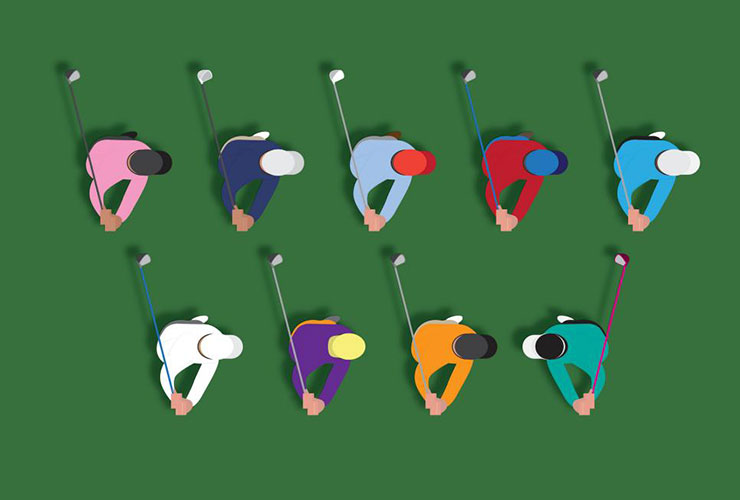After winning the Farmers Insurance Open earlier this year for his sixth PGA Tour victory, Max Homa reflected on his rapid rise over the last few years, saying “Sometimes you’re just one swing thought away from being good again.” Though us amateurs are not one swing thought away from ticking off six tour titles, finding the right swing feel can make a massive difference in our games.
If you clicked on this article, there’s a good chance you slice the golf ball, hitting weak flares and the occasional low pull off the tee. Good news: You’re likely a simple thought, tweak or feel away from hitting draws. Not buying it? The golfers featured in this article have seen the dark side and now draw the ball, thanks to some quick adjustments.
To hear directly from average golfers, we consulted Reddit’s golf page (which, if you haven’t checked it out, is full of relatable discussions) and asked the question “Former slicers, what was the swing feel or thought that got you hitting draws?” We’ve compiled the five most common responses below.
1. Set-up: Stronger grip and closed stance
Before making dramatic overhauls to your swing, start by adjusting your set-up. A quick grip, alignment or ball position change can improve your ball flight without any complex swing thoughts. That was the key for these former slicers.
“Strengthened my grip and started using a draw set-up instead of straight (club face aimed at target with a closed stance).”
“Stronger grip and making sure I’m coming in to out. Solved it pretty quickly.”
“I got fed up one day. Hit a few hundred balls using the ‘back to target drill.’ Basically, closed my stance about 45 degrees and kept hitting balls until they hooked. After that, no more slice.”
Butch Harmon recommends the same two set-up tweaks to fix a slice. Harmon says both changes will help you come more from the inside and release the club, addressing the two issues that cause a slice: a path that is too far out-to-in with a face open to the path.
2. Bow the lead wrist
It’s a trendy move right now on tour, most notably with Jon Rahm and Collin Morikawa having a bowed or flexed lead wrist at the top of the backswing and coming down. For slicers, it’s a move worth copying.
“I stopped cupping and started bowing my wrists. Went from a slice to a hook.”
“I stopped cupping my lead wrist at the top of the backswing like in a baseball stance. Slice be gone. Went the opposite direction, and now I bow my wrist. Miss is now a hook or occasional push right.”
A cupped wrist at the top of the swing opens the face and promotes a steeper downswing, leading to an excessively out-to-in path, says Jonathan Buchanan. Conversely, getting the lead wrist in a flat or even bowed position helps square the face and shallow out the downswing, allowing you to come from the inside to draw the ball. Check out Buchanan’s full explanation.
3. Flatter backswing
Having sufficient depth — how far the hands are from the golf ball at the top of the swing — is key to being able to come from the inside and hit a draw. Though tour pros have the flexibility needed to create depth, tight-muscled amateurs must work a little harder. The easiest way to create that depth if you struggle with flexibility? A flatter plane on the backswing. That cured the slice for these golfers.
“I flattened my swing significantly.”
“Flatter backswing and proper wrist flex.”
As Mark Blackburn — coach of numerous tour pros, including Max Homa — describes below, work on getting your lead arm more across your chest in the backswing to flatten out your swing. When videoing your swing from down the line, make sure your lead arm is either going through your trail shoulder or even below it at the top of the backswing. This flatter arm plane will give you the depth needed to attack the ball from the inside.
4. Change the swing shape
If you’re the slicer who takes the club way to the inside before swinging out over the top on the downswing, you’ll fix your slice by changing your swing shape.
“I saw a video about making a reverse loop (out on the backswing and in on the down). I exaggerated it and it worked.”
Oftentimes, the golf swing works in opposites. Rip the club to the inside on the backswing and you might be forced to lift and come over the top in transition. To flip this pattern, exaggerate the opposite. Think “Up, around and under,” says Jeff Ritter. Kenny Perry, one of the most consistent drawers of the ball in recent decades, had this sort of move, which put him on an inside path coming down. A great visual to create this loop is to feel like you’re tracing a figure eight with the club head, just as Lee Trevino does.
5. Hit a forehand
Hitting a draw is a lot like hitting a topspin forehand in tennis or ping pong. The feeling in both is the club, racket or paddle travelling from in to out through impact, and from low to high. If you’re slicing the ball, you’re using a backspin dropshot motion.
“I read somewhere that a golf swing should feel like hitting a forehand in tennis and that swing thought alone has fixed my slice.”
If you tend to get bogged down with technical thoughts, give this simple feel a try. David Leadbetter says it’s a great way to get out of the “slicey, cutty action” that creates weak fades. Exaggerate the move until you’ve got the ball working from right-to-left. If you overdo it and start hitting hooks, it’s easy to rein it back in.









